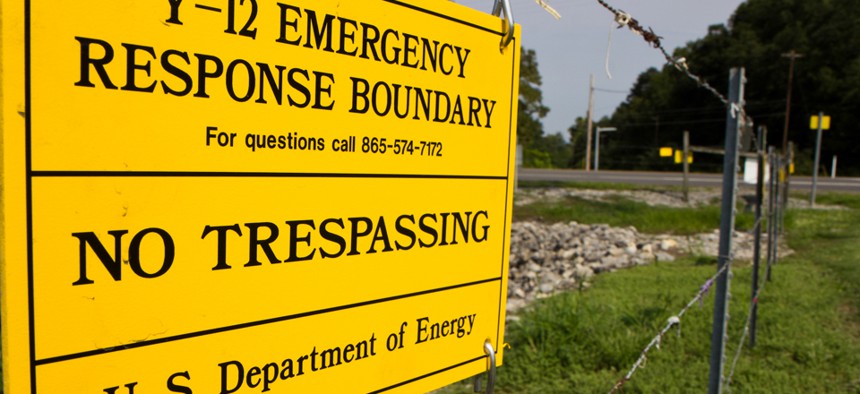Nuclear Weapons Complex Reform Could Mean Pay Cut For Contractors
Contracts have been under increased scrutiny due to repeated cost overruns, delays and security failures.
The for-profit companies that run the U.S. nuclear weapons complex might have a pay cut in their future, though by how much and exactly when is still unclear.
For decades the complex -- which includes the national laboratories and other facilities responsible for developing and maintaining the nation's atomic arsenal -- operated on a non-profit basis. Taxpayer dollars sunk into it went directly toward scientific work related to weapons development and nonproliferation efforts.
Since the early 2000s, however, the sites have been run by for-profit, limited liability companies. A portion of the annual budget for each facility is set aside as an "incentive fee." The better the job a contractor does managing a facility's work in a given year, the larger the percentage of the total available incentive fee the company gets to take home.
Lately these contracts have been under increased scrutiny due to repeated cost overruns, delays and security failures across the nuclear weapons complex. In one of the most dramatic examples, an 82-year-old nun and two other peace activists in 2012 were able to infiltrate the Y-12 National Security Complex in Oak Ridge, Tenn., where bomb-grade uranium is stored.
Associate Deputy Energy Secretary Bruce Held has been questioning whether what he describes as "large fees" currently paid to manage the weapons sites are the best way to motivate all players involved.
Performance at the national labs might actually improve, the former CIA officer says, if less money went toward the fees meant to motivate the management companies that run the sites, and if more funds went directly to the scientific work that the facilities conduct.
"What motivates the people at the national laboratories is excellence in science and bringing excellence in science to the interest of the nation … They're not motivated by profit incentives," Held told Global Security Newswire in a recent interview. "They're human beings, they need a salary -- you can motivate them at the margins by giving them a pay raise or a pay decrease or something like that -- but their core motivation and what makes them tick is scientific excellence.
"So if I have a choice between a dollar of fee for the … contractor that runs it, or a dollar in lab-directed research and development and I want to motivate scientific excellence, I'd go with" the dollar in lab-directed research and development, Held continued.
It is not completely clear, however, how Held, who says he was coaxed out of retirement from federal service specifically to work on the contracts question, would reconfigure the current for-profit approach.
Held, who completed a 10-month stint as acting head of the Energy Department's semiautonomous National Nuclear Security Administration last month, advocates for moving toward a "public interest model." He suggests, however, that he and other officials working for Energy Secretary Ernest Moniz are still wrestling with exactly what that means.
One significant change that appears to be in the works is an effort to make the maximum fee potentially available to the contractor smaller, and to have much of that fee be based on a fixed amount.
For example, in fiscal 2012, Los Alamos National Security, a limited liability company formed by Bechtel, Babcock & Wilcox and the University of California, had the potential to earn up to $74.5 million for its management of the Los Alamos National Laboratory in New Mexico, roughly 3 percent of the facility's $2 billion budget for that year.
Based on an annual performance evaluation, the government ultimately paid the company $59.7 million, 80 percent of what it could have earned with a perfect performance rating.
In the future, however, a facility like Los Alamos might be paid a fee that is only 1 percent of the site's budget, or closer to $20 million, an NNSA official explains. Most of that fee -- say, $18 million -- would be a fixed, guaranteed payment, meaning only a $2 million portion could be reduced due to less-than-stellar performance.
Another change Energy Department officials are pursuing is one where the fee amount would be fixed over the life of a multiyear contract, rather than having it renegotiated annually, said the NNSA official, who was not authorized to discuss the issue publicly and asked not to be named.
When fees are renegotiated annually "there's not an incentive to reduce your budget because the [larger the] budget, the more fee you get when you're basing your fee on the budget," the NNSA official said. "We're trying to incentivize them to find efficiencies and have a more efficient mission that drives savings."
Under this model, fees paid to the contractor would only be renegotiated on an annual basis if a facility's costs deviated from the president's budget request by more than 10 percent, according to the NNSA official. The semiautonomous Energy Department agency already implemented this change at its Kansas City Plant in Missouri in 2010 when it extended the contract with the Honeywell Corp. to run the facility, the official says.
Held hinted at some of these changes during his brief interview with GSN.
"Sandia [National Laboratories in New Mexico and California -- now run by Lockheed Martin] used to be a dollar a year," Held noted, referring to a prior arrangement in which the University of California and other organizations managed the national labs for a nominal fee.
"We're not going to get back to a dollar a year, but I think maybe we should do a fixed fee, not a percent of turnover. If you have percent of turnover, then you have an incentive to drive up your overall turnover rate."
When, and to what extent, these changes are to occur, is yet to be determined. Current contracts for Los Alamos and Lawrence Livermore National Laboratory in California are in place until at least 2018, and they include options that could extend them as far out as 2026. The current contract for Sandia, the third major lab, is set to expire this year.
"Typically the best time to [make a change] is when you're awarding a new contract," the NNSA official says. "Once you're in a contract, it’s a negotiation with the contractor you have in place, so it would have to be a bilateral agreement … It's easier in a competition, of course."
How the contractors might react to any changes is still unclear, according to Held.
"We're already engaging" with industry, he said. "We're starting to talk to people but we're not quite there yet."
Los Alamos Laboratory Director Charles McMillan, who also serves as president of the Los Alamos National Security LLC, declined to say much about the issue after a Senate hearing last month, during which he raised concerns about laboratory budget cuts generally.
"I'm not really in a position to comment right now," McMillan told GSN. "I know Bruce [Held] is thinking a lot about those issues, and at some level this is an issue that the government is the one that has to make the decision."
Meanwhile, failures across the nuclear weapons complex -- which, in addition to the Y-12 break-in also include numerous delays and cost overruns to various projects -- have rekindled a long-simmering debate in Congress over how the facilities should be managed.
The Republican leadership of the House Armed Services Committee in recent years has favored legislation that would further limit the Energy Department's oversight of the facilities. Oversight by the department, which owns the sites, was previously scaled back by the creation of the semiautonomous National Nuclear Security Administration in the early 2000s. That move followed a prior string of scandals across the complex.
Republicans on other House committees, along with senators from both parties, largely scuttled major legislative reforms in favor of creating a new congressional advisory panel to first study a broad array of governance issues facing the weapons complex. How to best structure the management contracts is on the agenda of the panel, whose final report is expected this year.
So far, the leaders of the so-called "Congressional Advisory Panel on the Governance of the Nuclear Security Enterprise" have said it is clear that the "'NNSA experiment,' involving creation of the semiautonomous organization, has failed," in a general sense, but they have yet to offer any specific fixes.
Panel Co-Chairman Richard Mies, a retired Navy admiral, said, however, that the group has observed inconsistences in how contracts are structured across Energy Department laboratories, including those that work under its Office of Science and the NNSA sites.
"When you compare all the laboratories across the Energy Department there isn't a kind of standard template for how they're awarded -- what percentage is fixed fee, what percentage is award fee, how much of the fee is a percentage of their budget -- those kind of issues," Mies told GSN. "I think there needs to be some standardization."
Mies said that, in his view, the fee NNSA lab management contractors receive currently "is not exorbitant," however.
"The fee is three percent of the total budget," Mies said. "A standard utility makes a 10 percent profit …
"But there is this inequity where some labs are getting one percent of the budget -- other labs are getting a three percent fee," Mies added. "So, why the difference? Shouldn't there be more consistency and balance? Clearly the difference between fixed fee and award fee makes a difference, as well. We're looking at all of those issues to try to find some reasonable balance."
Panel Co-Chairman Norman Augustine said there are pros and cons to having for-profit companies involved in the management of the NNSA labs.
"With [a DOE Office of Science] lab, they can get a university, which is basically a not-for-profit institution," Augustine told GSN. "But when you're doing manufacturing and managing huge programs -- [those are] not things that universities are very good at.
"So that means you have to get the corporate world involved, and when you bring the corporate world in, they have shareholders they have to accommodate," Augustine added. "They also care about the national interest … but there has to be some reasonable balance and we hope we can strike that."
NEXT STORY: What It Will Take to Improve Morale






